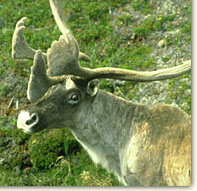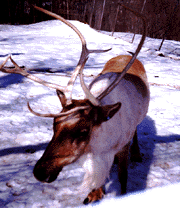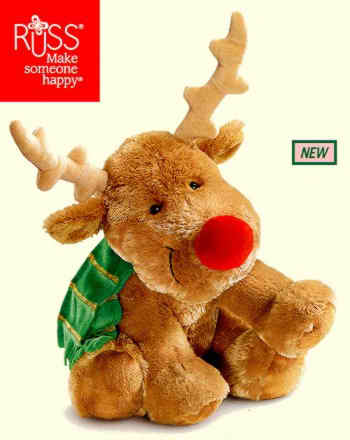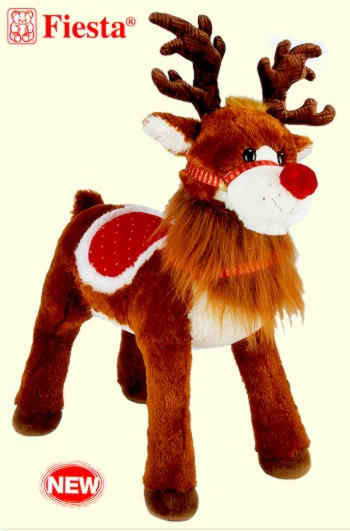Get the Inside Scoop on Caribou & Reindeer
Rangifer tarandus
Wild caribou and domestic reindeer are considered to be a single species throughout the world.Caribou are rather large members of the deer family.
Their broad, concave hoofs spread to aid walking on soft ground and are good for digging in snow. Both genders grow antlers that in males serve as ornaments and weapons for fighting rivals
during the breeding season.Alaskan caribou are clove-brown with a white neck and rump. Chukotkan reindeer, as a result of
domestication, have varied pelt combinations of brown, grey, black and white in the same herd.
Alaskan Caribou

Reindeer and Caribou look different, but they probably are the same species. Caribou are large, wild, elk-like animals which can be found above the tree-line in arctic North America and Greenland.
Because they can live on lichens in the winter they
are very well adapted for the harsh arctic tundra where they migrate great distances each year. Caribou cows and bulls both grow distinctive antlers and bull antlers can reach 4 feet in width! A Caribou calf can run within 90 minutes of its birth. It must do this to keep up with the migrating herds.
Reindeer are slightly smaller and were domesticated in northern Eurasia about 2000 years ago. Today, they are herded by many Arctic peoples in Europe and Asia including the Sami in Scandinavia and the Nenets, Chukchi and others in Russia.
These peoples depend on the reindeer for almost everything in their economy including food, clothing and shelter. Some Nenets even keep reindeer for pets!
Reindeer were introduced into Alaska and
Canada last century, but most attempts failed. Native peoples in these countries still prefer to hunt caribou rather than herd reindeer.
Reindeer and caribou have unique hairs which trap air providing them with excellent insulation. These hairs also help keep them buoyant in the water. They are very strong swimmers and can move across wide rushing rivers and even the frozen ice of the Arctic
Ocean!
Reindeer

Reindeer
In Eurasia people long ago began to tame wild caribou. Some anthropological studies suggest that this occurred in the southern Altai mountain region about 5,000 years ago.
All domesticated reindeer may have derived from those stocks, for modern attempts to domesticate animals from wild caribou populations have not succeeded.
It is speculated that initially hunters learned that tamed deer on a leash could help them sneak closer to wild herds. Later tame animals were used to pull sleds,
and in some cultures they were saddled and ridden.Eventually people kept herds as a dependable source of food, hides and transport. Today, from the Sami (or "Lapps") in Scandinavia, all across northern Eurasia to the Bering Strait, there are Native peoples who base their economies upon the herding of reindeer.
Modern uses include the former ones, plus commercial sales of meat and some hides. Recently, the sale of antlers to the Orient has become important. In the Russian Republic today, reindeer number
about 2,250,000.
Different reindeer varieties have been developed in Asia to suit local conditions and human needs, including transportation.
Chukchis have a breed that appears to be the product of longer domestication than most. Excellent for meat production, they are not so good for pulling sleds. The Chukchis may have begun keeping larger herds for commercial meat and hide production in response to the 17th century arrival of Russians.Under the Soviet system Chukotkan herders were organized into brigades, each responsible for 500 to 2,000 reindeer. Larger numbers of reindeer were kept on the Chukotsk Peninsula and the long migrations to the west discontinued. There are no forests on the
peninsula and winter can be particularly difficult; nearly half the reindeer died in the winter of 1984.
Life in a reindeer camp remains traditional in many ways, based on the mutual dependence of reindeer and people. Reindeer hides supply beautiful, light and warm clothes enabling people to work in the severe cold. Winter hides, one of the best available natural insulators, furnish tents, provide bedding and, sewn
together with sinew, become the winter coverings of the large round tents called yarangas.
Despite the long history of cultural contacts and movements across Beringia, reindeer Husbandry was evidently not transmitted to North America until Chukchi and Sami herders and Chukotkan reindeer were brought to Alaska in the late 19th century to teach herding to Eskimos.The Seward Peninsula is home to most of
Alaska's reindeer, about 17,000 in herds owned by local Eskimos and Native corporations. Herds range throughout the peninsula, including within the Bering Land Bridge National Preserve, where
the continuance of herding is allowed by law.
Adorable Stuffed Plush Reindeer Here
Stuffed Rudolph Reindeer
Back To Santa Claus & Christmas Index
For Really Cool Pet Related Gift Items
Pet Gift Shop Here
Reindeer Calendars
Free Dog Care Tips
Free Cat Care Tips
Free Horse Care TipsHome
Copyright ©
Choose To Prosper


